You will be met in the arrivals lounge of new Delhi international Airport and transferred to your hotel where you can relax on your first day.



If you would like to see some of the main sights of Delhi or get a feel for this bustling city then we can organise a sightseeing tour of the city for you or you can just relax after your international flight
Today we depart for the airport after an early breakfast and our short flight to Jabalpur. We are met at Jabalpur and transferred via private vehicle to King's Lodge.
Situated in the central Indian state of Madhya Pradesh, Bandhavgarh National Park is a 448 km2 renowned tiger reserve. Nestled among the picturesque Vindhya and Satpura ranges, this is one of India's most beautiful national parks. The dramatic landscape features tropical forests and woodlands, and steep rocky hills with flat grasslands in the valleys below
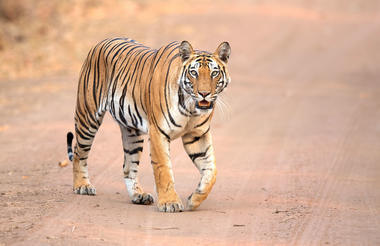


Travelling around India - The country is large so most of the longer distances are best done by flying. Our flight departs Delhi at 10.10 and we should arrive in Jabalpur at 11.50. It is then a 170km road trip to Bandhavgargh ( circa 3-3.5 hours)
The road trips are a good way to see the country and our guide will be able to explain this rural area as we pass through the villages and fields
Bandhavgarh supports one of the highest densities of tigers on the Subcontinent. Its hilly open terrain includes many large grassland meadows that offer good chances of sightings. The density of its big cat population has made Bandhavgarh world famous. The Park is also home to a large variety of mammals: leopard, chital (spotted deer), Sambar deer, nilgai, wild boar, chinkara, sloth bear, rhesus macaque, grey langur, jungle cat, hyena, porcupine, jackal, fox, and wild dog. Morning and afternoon game drives in Bandhavgarh National Park.


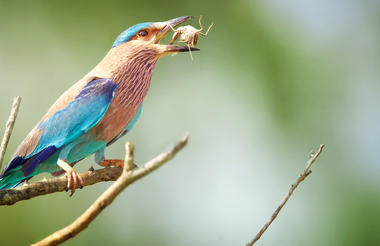
This is not simply a reserve with a high density of tigers and cubs. Keep an eye out for long- billed vultures that circle around the hill fort, dragonflies around watery meadows, chital herds around the pools, sloth bears and the Malabar pied hornbills whose shriek is instantly recognisable. The great forests of sal hardwood trees and ever-changing greens, browns and yellows of the deciduous crocodile bark and tendu trees or clumps of bamboo hide many treasures against the stunning backdrop of the sheer sandstone cliffs of the ancient Vindhya range. This is a park with much to offer the seasoned nature traveller and the first timer.
Morning and afternoon exclusive jeep safaris - Bandhavgarh National Park
This morning we enjoy our exclusive jeep safari into Bandhavgarh National Park and then after lunch we are free to relax in the lodge grounds and enjoy the local bird life or go on a cycling or walking trail. The organic garden and butterfly farm are also popular as well as visits to the local village
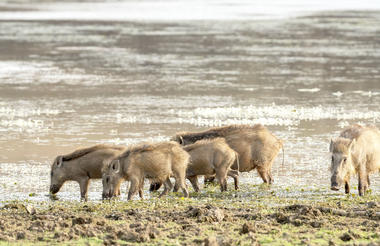


It is hard to imagine as you drive through these forests that this area was originally home to powerful kings and Maharajas residing in the large hilltop fort; its meadows were rich agricultural lands tended by farmers and Buddhist monks; and sadhus occupied an extensive cave system in 100 BC. Bandhav-garh means ‘fort of the brother’ and is believed to have been gifted by Lord Ram to his brother Lakshman. In the twelfth century, the fort was given in dowry to the Baghela clan, of which the present Maharaja of Rewa is a direct descendent. After almost continuous occupation, the capital of the Baghelas was moved to Rewa by the nineteenth century and the forests became the hunting reserve of the Maharaja and his guests. Gulab Singh of Rewa shot 480 tigers across his kingdom. By 1968, all the animals in the park had been hunted out and on the day the present Maharaja’s late father gifted the forests to the State, there were no quadrupeds left in the park. Soon after, the forests were declared a National Park and later a Tiger Reserve. The park was extended in 1986 and today it covers 1,161 square kilometres, including the buffer areas, in which village communities exist. Famed over the years for its charismatic male and female tigers that are well documented, it today has over 90 individuals residing within its forests. The park is divided into three separate tourism zones - Tala, Magdhi and Khitauli.
Morning exclusive jeep safari - Bandhavgarh National Park
After Breakfast we leave Bandhavgargh and are transferred by private vehicle to Singinawa Jungle Lodge for our stay at Kanha National Park. The journey is 215km and en route we will stop for a pack lunch.
Kanha is one of India's largest national parks, covering 1945 km², and is located in the Maikal Hills of the Satpura Hills range in the south eastern part of the state of Madhya Pradesh. The Park has beautiful areas of sal forests, large bamboo stretches and lush green meadows.
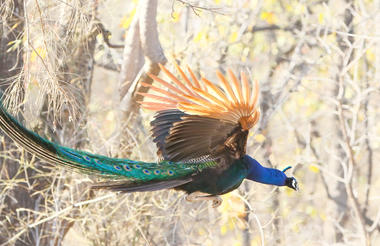
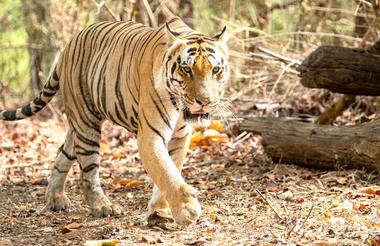
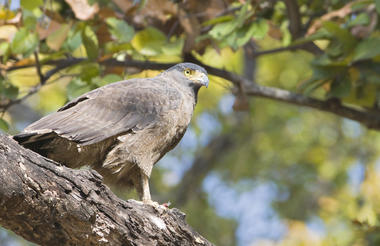
Kanha faces similar pressures to most protected areas, including developmental and infrastructure projects, grazing, illegal poaching, woodcutting, forest product extraction and bush meat off-take. It also has both historic and present issues with compensation and support for many of the Baiga and Gond village communities relocated over the years to make way for viable wilderness habitation. However recent research highlights the economic value of the park at R 1,650 crores (£176 million per year) ensuring support for this well managed park continues.
Kanha is not only famous for its Tiger sightings, but also for the highly endangered central Indian race of the Swamp Deer or Barasingha. Once down to to less than 70, their population today is between 400-500 animals.
Other herbivores found here are Chital, Sambar and the Muntjac, which along with Wild Boar form the main prey base for Tiger. Parts of Kanha are good habitat for the Dhole or Indian Wild Dog. Birdwatching here is nonetheless a rewarding experience. Of the species to be seen in the Park are the Crested Hawk Eagle, Crested Serpent Eagle, Large Raquet-tailed Drongo, Paradise Flycatcher, Golden Oriole, several species of cuckoos, nightjars and owls. The grasslands are the habitat for birds like the Zitting Cisiticola, Jungle Prinias and Painted Partridge along with seed-eaters such as the various species of munia.
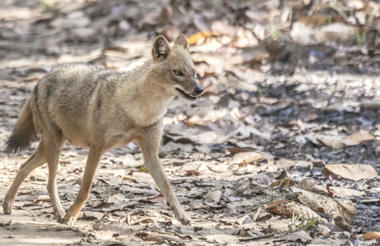
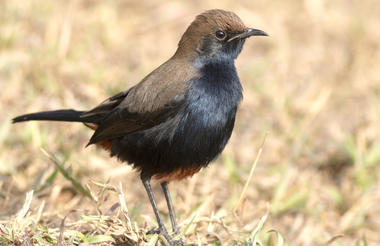
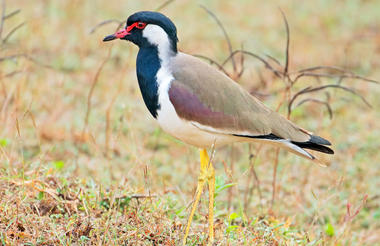
Stopping your vehicle beside one of the large golden grass meadows with the sunbeams angled by the tall sal forest behind you; a morning mist and the unseen crack of horns from a pair of barasingha stags clashing and you might well be reminded of Mowgli’s forests made famous by Rudyard Kipling. These lowland forests are a mixture of great sal hardwood trees, once heavily felled for railways sleepers and other mixed species of forest. It is interspersed with grassy meadows - the habitat of spotted deer, the rare hard ground barasingha and ambush ground for the tiger. The higher forests are more tropical with bamboo growing in clusters within which gaur, wild pig, sloth bear and sambar deer make their homes. With all this prey, tigers are numerous too (over 100 at last count) and habituated to jeeps, ensuring memorable sightings. The Reserve lies in the east of the Central Indian highlands of the ancient Satpura mountain range. Here, flat-topped hills support grassy meadows and the river Sulkum flows through the valley. The Banjaar and Halon valleys used to be hunting grounds of the British who would hunt the barasingha deer but their rapid decline in numbers forced the authorities to gazette Kanha as a Sanctuary in 1933. In 1955, a 250 square kilometre patch of land was declared the Kanha National Park. The Mukki Valley was added to the Protected Area in 1970 and then, thanks to Project Tiger, a vital part of the upper Halon Valley was also included. Today it stretches over an area of 940 square kilometres with a surrounding buffer zone of 1,134 square kilometres. Along with the neighbouring Phen Sanctuary, it forms the Kanha Tiger Reserve. There are four tourist zones here, each worth a visit - Kanha, Kisli, Mukki and Sarh
Morning and afternoon exclusive jeep safaris - Kanha National Park
Morning and afternoon exclusive jeep safaris - Kanha National Park
This morning we enjoy our jeep safari in the National Park.
This afternoon we are free to relax or simply enjoy the prolific birdlife in the lodge grounds. Cycling and village tours are also on offer.



Well known individual tigers are sought out commonly including many tigresses with cubs. However, leopards, sloth bears and exciting packs of hungry wild dogs or dholes also abound in these forests. Prey species like the chital and sambar are found grazing in herds. The barasingha or swamp deer (hard ground swamp deer) is found only in Kanha and barely 1,200 of them survive in the wild. Look out for rhesus macaque, golden jackal, Bengal fox, smooth- coated otter, honey badger, small Indian civet, Indian grey mongoose, spotted chevrotain and pangolin. There are also 175 varieties of birds in Kanha including the purple heron, shikra and white-eyed buzzard. The Indian ghost tree (kullu) is hard to miss with its ghostly white trunks. The sap from these trees is used in the production of chewing gum!
Morning exclusive jeep safari - Kanha National Park
After breakfast we drive to Pench National Park which is 195km away. here we will stay in the lovely Pench Tree Lodge.
Pench National Park is a wild playground harbouring the country's maximum density of prey animals, chased by an estimated 65 Tigers. In 1983, it was declared a National Park and in 1992, a tiger reserve


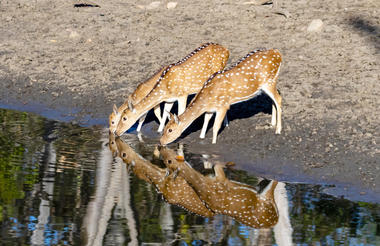
Tiger is the main cat species but commonly seen wildlife includes chital, sambar, nilgai, wild boar and jackal. Other wild animals found are leopard, sloth bear, wild dog, porcupine, jungle cat, fox, striped hyena, herds of gaur, four- horned chowsingha and barking deer. There are more than 170 species of birds including several migratory ones. Some of them are crimson- breasted barbet, red-vented bulbul, racket-tailed drongo and magpie robin with lesser whistling teal, pintails, river terns and northern shovellers on or near water bodies.
Pench National Park has an appealing landscape of dry and moist deciduous forest and Teak is the major tree of the region along with a mix of Saja, Mahua and Indian Ghost trees. The vegetation is of undulating scrublands as well as bamboo patches around hilly areas. The park has 39 recorded species of mammals, 210 species of migrant and resident birds and estimated 30 species of reptiles. The park is known for good sightings of Tiger, Wild Dogs, Jackals and many other mammals & birds.



The evidence is undeniable, the feeling palpable, as you drive down the dusty dirt tracks, that around every corner a drama will unfold, a glimpse caught, a movement spotted. The sun-dappled forest floor is alive with spotted deer. Vast herds also gather on the shorelines of the park’s reservoir, offering a smorgasbord of food for Pench’s hungry carnivores that include leopards, wild dogs and tigers (thought to be close to 65). The remarkably unshy tigress, Collarwali, who has nurtured 20 cubs in five litters and whose mother was featured in the BBC’s Spy in the Jungle series is a treat to spot. It was here that Rudyard Kipling chose to base his story of the wolf boy Mowgli. However, it wasn’t until 1992 that Pench was included under the umbrella of Project Tiger. Today, the Reserve covers districts of Madhya Pradesh and Maharashtra. The park is predominantly a teak forest, but other hardwoods and flowering trees support a rich and diverse array of birdlife too.
Morning and afternoon exclusive jeep safaris - Pench National Park
Following our morning jeep safari to Pench we have lunch and then the afternoon is free to relax or join one of naturalists for an afternoon trail on foot or by bicycle. Alternatively you can enjoy a night walk with the naturalist searching for the nocturnal animals rarerly seen during the day



Seeking a tiger doggedly can cause you to miss the whine of the cicada, the sight of the common butterfly or the shrill call of a crested serpent eagle. It’s India’s densest population of prey species, nearly 25,000 of them, including spotted deer, wild pig and sambar deer. In April when the Pench River dries out, the animals use dohs or perennial springs as waterholes, or crowd the shoreline and tender grasses of a receding reservoir. It acts as an artificial wetland where you can see hordes of water birds sitting on what were the tree stumps of flooded woodlands
Morning exclusive jeep safari - Pench National Park
We leave this morning for our private transfer to Svasara Lodge in Tadoba National Park. The journey should take around 4 hours and we will have a picnic lunch en route.
Tadoba Tiger Reserve is a rare jungle jewel amongst India’s leading tiger reserves and national parks. It is affably called the Land of the Tigers, due to its high tiger density—recent estimates indicate around 72 tigers (60 in core and 12 in buffer) over a rich jungle spread over 625 square kilometres!
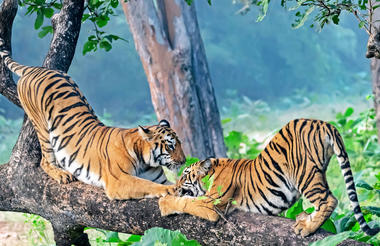
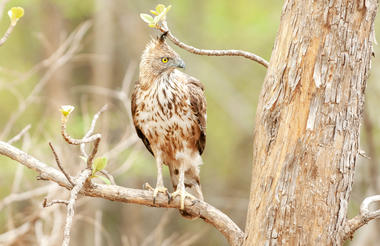
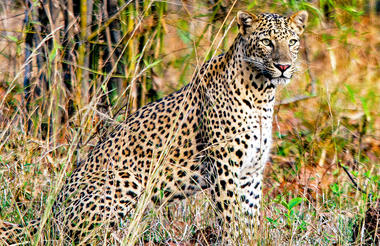
Game drives are largely along the more accessible and open Western side. In the Tadoba range, make sure to stop at Katezari, which is an evergreen valley, drive around Tadoba Lake and Pandharpauni meadows that have two waterholes where animals make frequent visits. In the Mohurli range, visit the Telia Lake, which is a good place to spot migratory birds and Andhari Nala is excellent for gaur sightings.
Visitors report frequent tiger and wild dog sightings and, in general, the park offers plenty of opportunities for close encounters of the wildlife kind which also include: Leopard, Sloth Bear, Gaur (Indian Bison), Rusty Spotted Cat, Ratel, Indian Mouse Deer, Spotted Deer, Sambar, Wild Pig, Four Horned Antelope, Flying Squirrel, and more. Over 200 species of birds include the crested serpent eagle, honey buzzard, paradise flycatcher, grey-headed fishing eagle, the shy jungle fowl, and much more.
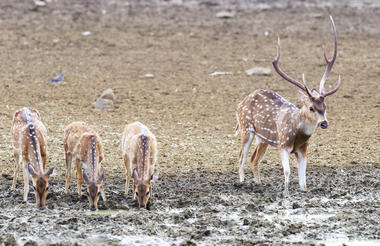
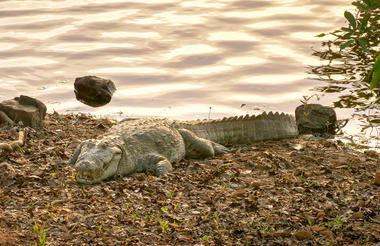
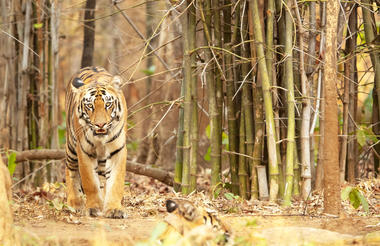
This classic teak and bamboo paradise epitomises a Central Indian jungle - from the lush green foliage in early monsoons, to the dry and dusty browns and yellows of summer, you can enjoy Tadoba’s beauty throughout the year. Often referred to as The Jewel of Vidharba, Tadoba was overlooked until very recently. Visionary management and better protection now ensures it sits amongst the best parks in India with recognised tigers and their playful cubs residing around picturesque lakes like Tadoba and Telia, and the meadows of Panderpuni, Khatoda and Jamunjhora. Recent village relocation programmes are opening up new areas and new habitats and the greater area now contains over 100 tigers in its 1,854 square kilometres area.
We leave the wildlife of India behind this morning for our private transfer to Nagpur Airport and our flight back to Delhi arriving at 13.00. Here we will be met at the domestic terminal and transferred to Indira Gandhi International Airport in good time for our onward flights home





